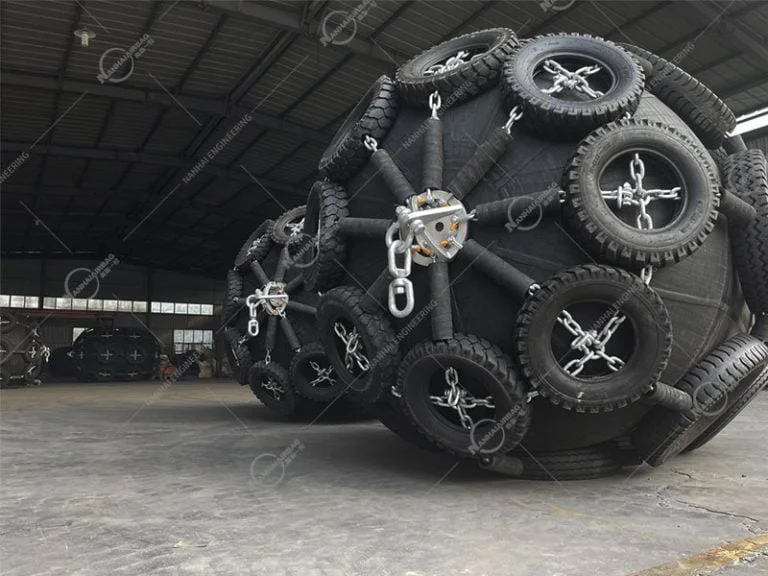Why ISO 17357 Compliance Matters for Pneumatic Fenders?
05/27/2025How Pneumatic Fenders Work: Structure, Function, and Benefits
05/28/2025Why LNG Terminals Prefer Pneumatic Fenders for Mooring Safety?
When it comes to mooring massive LNG carriers, safety isn’t just a priority—it’s a necessity. Pneumatic fenders, also known as air-filled marine fenders, have become the go-to solution for LNG terminals worldwide. Here’s why these ship fenders are the preferred choice for ensuring mooring safety in the demanding environment of LNG terminals.

Exceptional Energy Absorption and Low Reaction Force
Pneumatic fender are designed to absorb significant kinetic energy during vessel berthing, effectively minimizing the impact force transferred to both the vessel and the port infrastructure. This feature helps prevent damage to ships, quaysides, and other structures, reducing repair costs and downtime.
Adaptability to Challenging Conditions
LNG terminals often face harsh environmental conditions, including strong tidal currents and extreme temperatures. Pneumatic fender maintain their performance in such conditions, ensuring reliable protection for vessels during mooring operations. The pneumatic fender manufactured by Nanhai are designed to handle the harsh environment, even berthing at an angle of up to 15 degrees. Their ability to adapt to tidal changes and provide stable protection makes them ideal for LNG terminals.
Durability and Longevity
Constructed with high-quality rubber materials and reinforced with tire-cord layers, pneumatic fender offer excellent abrasion resistance, aging resistance, and UV resistance. This ensures long-term use in marine environments without cracking or hardening. Nanhai can also add a chain tire net according to the application environment and customer requirements. Regular inspections and maintenance can extend their lifespan, making them a cost-effective choice.
Ease of Installation and Maintenance
The installation process of pneumatic fenders is relatively simple, without requiring large lifting equipment or complex steps. Installers only need to deploy the fenders at the designated location and inflate them. Routine maintenance includes regular checks of inflation pressure and air tightness, inspection of the surface condition, and timely repair of damaged parts. The process of inflating and deflating is quite straightforward, allowing you to save on shipping costs during transport. Plus, once deflated, it can be conveniently stored right on the deck.
Environmental Benefits
Pneumatic fenders have significant environmental advantages. They use sustainable materials, reducing resource consumption and carbon emissions. Compared to traditional fenders, pneumatic fender have a smaller environmental impact, better adapt to changes in the marine ecosystem, and comply with environmental regulations and sustainability requirements.
Versatility Across Marine Applications
Beyond LNG terminals, pneumatic fender are widely used in various maritime applications, including commercial ports, offshore platforms, and ship-to-ship transfer operations. Their adaptability and effectiveness in different scenarios make them a versatile choice for ensuring mooring safety across the maritime industry.
Conclusion
Pneumatic fender play an indispensable role in ensuring mooring safety at LNG terminals. Their exceptional energy absorption, adaptability to challenging conditions, durability, ease of installation, environmental benefits, and versatility across marine applications make them the preferred choice for LNG terminals worldwide. Investing in high-quality pneumatic fender is a strategic decision that enhances safety, reduces operational costs, and supports sustainable maritime operations.
People Also Ask
What are the advantages of pneumatic fenders over traditional fenders?
Pneumatic fenders offer superior energy absorption, adaptability to various conditions, and ease of installation compared to traditional solid rubber fenders. Their low reaction force reduces stress on vessels and port structures, enhancing mooring safety.
How do pneumatic fenders contribute to environmental sustainability?
By using sustainable materials and reducing the risk of collisions and spills, pneumatic fenders minimize environmental impact and help ports comply with environmental regulations.
Are pneumatic fenders suitable for all types of vessels?
Yes, pneumatic fenders are versatile and can be used for various vessel types, including LNG carriers, oil tankers, bulk carriers, and offshore platforms. Their adaptability makes them suitable for diverse maritime applications.
How long do pneumatic fenders last?
With proper maintenance, pneumatic fenders can have a long service life, often exceeding that of traditional fenders. Regular inspections and timely repairs ensure their longevity and performance.
For more information on pneumatic fenders and how they can enhance mooring safety at LNG terminals, feel free to contact us or explore our range of marine fender solutions.
